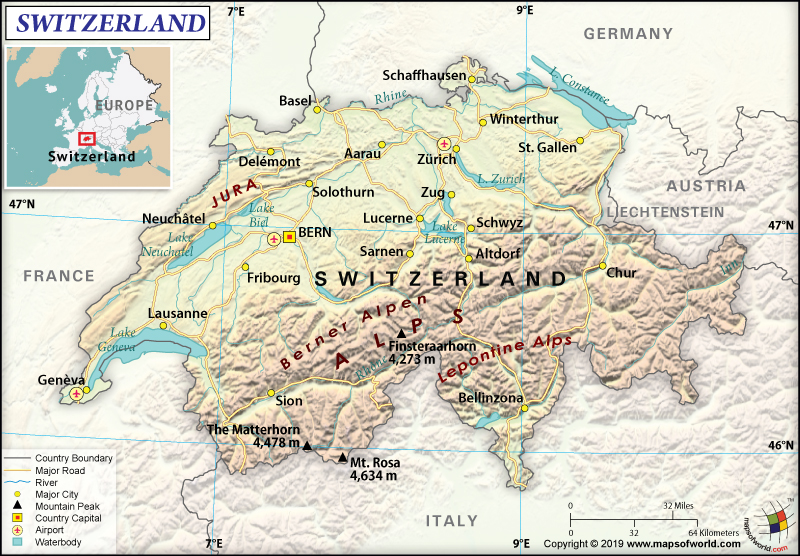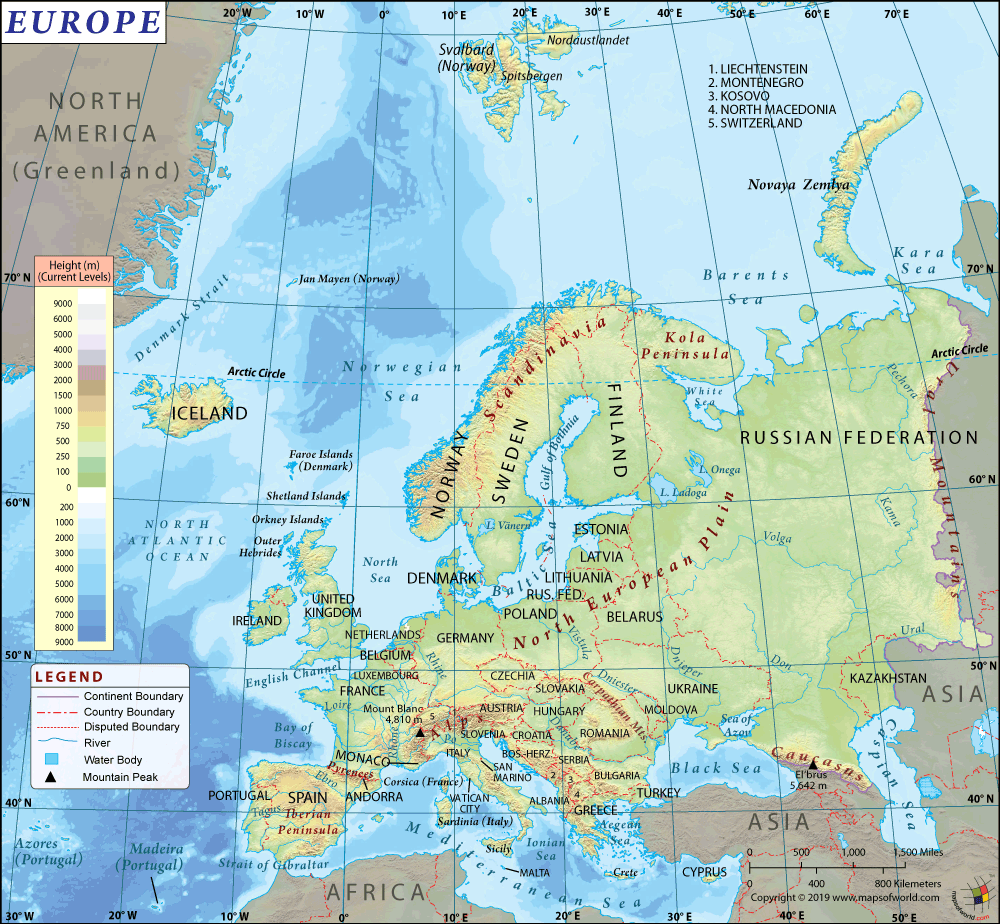What are the Key Facts of Switzerland?

|
Official Name |
Swiss Confederation |
|
Continent |
Europe |
|
Capital |
Bern |
|
Largest City |
Zürich |
|
Coordinates |
47.000000, 8.000000 |
|
Area |
15,940 sq. mi ( 41,285 sq. km) |
|
Land Boundaries |
1,100 mi ( 1,770 km) |
|
Coastline |
0 mi ( 0 km) landlocked |
|
Currency |
Swiss franc (CHF) |
|
Neighboring Countries |
Germany, France, Italy, Liechtenstein, Austria |
|
Population |
8,508,898 (2018 est. ) |
|
Official Languages |
German, French, Italian, Romansh |
|
Major Religion |
Christianity |
|
National Day |
1 August (Swiss National Day) |
|
National Anthem |
“Swiss Psalm” |
|
Form of Government |
Federal republic |
|
President |
Ueli Maurer |
|
Vice President |
Simonetta Sommaruga |
|
GDP per capita (PPP) |
$ 68,943.4 (World Bank, 2018) |
|
GDP per capita (nominal) |
$ 82,838.9 (World Bank, 2018) |
|
HDI |
0.944 (2017), Rank: 2 |
|
Literacy Rate (%) |
NA |
|
Space Agency |
NA |
|
Military Expenditure Ranking |
38 (SIPRI, 2017) |
|
No. of Olympic Medals |
345 (as of 2018) |
|
Driving Side |
right |
|
Calling Code |
+41 |
|
Time Zone |
UTC+1 (CET), Summer (DST) UTC+2 (CEST) |
|
Internet TLD |
.ch |
Where is Switzerland?
Switzerland is a central European country that is located east of France and north of Italy. It is a landlocked country that shares its border with 5 countries: Italy (698 km or 434 mi), France (525 km or 326 mi), Germany (348 km or 216 mi), Austria (158 km or 98 mi), and Liechtenstein (41 km or 25 mi). Check out this – Map of Switzerland and Other 35 Related Swiss Maps for more maps and info about Switzerland.
What is the Geography of Switzerland?
Switzerland is spread across a total area of 41,285 sq. km (15,940 sq. mi), out of which 39,997 sq. km (15,443 sq. mi) is land and 1,280 sq. km (494 sq. mi) is water. It has a total land boundary of 1,770 km (683 mi) with no coastline.
To begin with, there are 3 basic topographical areas located in Switzerland and they are the Swiss Alps, Swiss Plateau (also called Central Plateau), and the Jura mountains. The Alps Mountains are the most well-known landform in the country. These high mountains are located in the central-south area of Switzerland and encompass around 60% of the total area of the country. The second topographical area is the Swiss Plateau, located along the east-west axis of Switzerland. Most of the population lives in this plateau and the rolling hills. The smaller Jura Mountains are another important topographical area of Switzerland, located in the north-west direction of the Swiss Plateau.
Further, Dufourspitze (Monte Rosa) is the highest elevation point of Switzerland having a height of 4,634 m (15,203 ft). The lowest elevation point is Lake Maggiore, having a height of 195 m (640 ft). This country’s mean elevation point is 1,350 m (4,429 ft).
Furthermore, Lake Geneva and Lake Neuchatel are the largest lakes in Switzerland. There are more than 1,500 lakes in Switzerland, encompassing 6% of the freshwater stock of Europe. A large part of the landscape is covered under the glaciers, spread across an area of 1,063 sq km (410 sq mi). Many major rivers of the country including Rhone, Rhine, Ticino, and Inn originate from these glaciers.
Switzerland has a temperate climate. While glacial conditions are found on the mountain tops, pleasant Mediterranean climate is found in the southern tip.
Summertime is best for pastures and grazing because of the warm and humid weather along with periodic rainfall. The winters in the mountains are less humid. These regions may see stable conditions for weeks. However, the lower lands sometimes can’t even see the sun for weeks.
Furthermore, a peculiar weather condition called föhn (unexpected warm winds) may take place at any time of the year. This especially is detected on the Alps’ southern face. These are the dry and warm winds that descend from the top, down the leeward side (rain shadow) of a mountain range, after shedding their moisture on the windward side. These winds contribute to a rise in the temperature.
The inner alpine valleys receive least rain, creating the driest conditions. Graubünden and other large alpine areas remain dry too, even drier than the pre-alpine areas. The high Alps mountain areas receive the highest amount of rain. Rain bursts are noticed from time to time, even when the area gets lots of sunlight. Rainfall increases during summertime. Least amount of rainfall takes place during the autumn.
What is the Economy of Switzerland?
Switzerland is considered one of the wealthiest countries of the world in terms of per capita wealth. This high-tech economy is stable, prosperous, and had a nominal GDP of US$705.501 billion in 2018. This advanced, free market economy has ranked fourth in the Global Competitiveness Report of 2018-2019.
Generally, most of the population (over 70%) is involved in the service sector, followed by industry (around 20%). Below 5% of the population is involved in agriculture. Manufacturing is the most important industrial sector. Chemicals, health/pharmaceutical goods, measuring instrument (scientific and precision), and watches are the major export goods.
Moreover, the most important service sectors in Switzerland are banking, insurance, international organizations, and tourism. The unemployment rate is low (hovers around 3%) and mostly remains well below the 5% level.
What is the Transportation System of Switzerland?
The transport system of Switzerland is based mainly on railways and roadways.
In fact, 71,557 km (44,463 mi) of roadways are present in the country and all of them are paved. 1,458 km (906 mi) of expressways are there in Switzerland. 5,196 km (3,229 mi) of the railway network is spread across the country, out of which 3,836 km (2,384 mi) is standard gauge and 1,630 km (1,013 mi) is narrow gauge.
Additionally, Switzerland has 63 airports, out of which 40 have paved runways and 23 unpaved. 2 heliports are also present. As the country has a wide network of natural lakes, waterways are also quite widespread. 1,292 km (803 mi) of waterways are present in the country.
What International Organizations is Switzerland part of?
UN, WTO, Australia Group, NSG, BIS, CD, CE, UNESCO, CERN, EAPC, WHO, EBRD, EFTA, UNHCR, ESA, FAO, FATF, G-10, IADB, IAEA, UNCTAD, IBRD, ICAO, ICCt, UNIDO, ICRM, IDA, IEA, IFAD, IFC, IFRCS, Paris Club, Interpol, ILO, IMF, IMO, IMSO, IOC, IOM, IPU, ISO, ITSO, ITU, MIGA, MINUSMA, MONUSCO, NEA, OECD, OIF, OPCW, OSCE, PCA, PFP, Schengen Convention, UNITAR, UNMISS, UNMOGIP, UNRWA, UNTSO, UNWTO, UPU, WCO, WIPO, WMO, ZC, EITI (implementing country), ICC (national committees), ADB (nonregional member), AfDB (nonregional member), IGAD (partners), ITUC (NGOs), LAIA (observer), Pacific Alliance (observer), OAS (observer)
Related Links:


